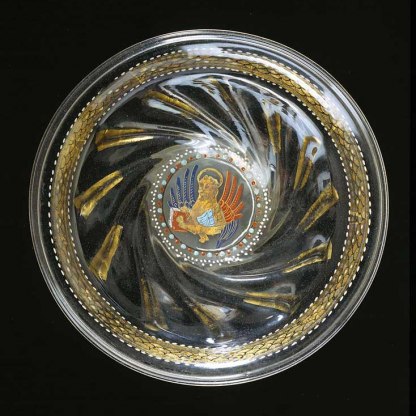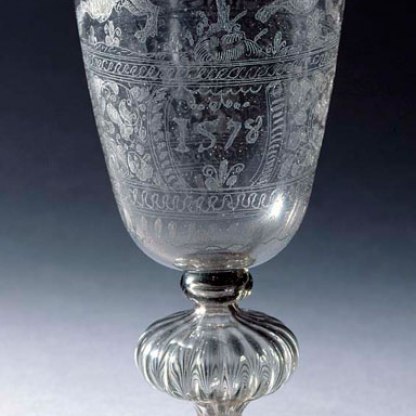Mosque Lamp

'Allah is the light of the heavens and the earth; his light is like a niche in which is a lamp...' (Qur'an, Sura 24: 35f.)
This verse come from a celebrated chapter in the Qur'an known as the Sura of Light, the first few words of which are painted in a highly stylised Arabic script, in blue enamel, around the neck of this ornate glass vessel. The quotation suggests that the object – known as a mosque lamp – has a metaphorical value as much as a functional or aesthetic one: it symbolises Allah whose 'light is like a niche in which is a lamp'. The lamp is a visual embodiment of the Creator.
Many vessels of similar quality and decoration were made in Syria in the fourteenth century for the magnificent new mosques of Cairo in Egypt, the centre of Islamic power at that time. They are really containers for oil lamps which would have been hung high, suspended from the roof of the mosque by metal wires or chains which ran through the loops around the belly. Around the loops on this example a second inscription identifies the Islamic potentate for whom it was made:
'By the order of the most noble authority, the Exalted, the Lordly, the Masterful, holder of the sword, Shaykhu al-Nasiri.'
Emir Shaykhu was a powerful figure in mid-fourteenth-century Cairo. Between 1350 and 1355 he endowed a magnificent mosque and a college in the city, and it is likely that this lamp comes from one of these two institutions. The emblem of the cup, that occurs three times around the neck, alludes to his one time role as cup-bearer to the sultan. The emir was murdered in 1357.
The period in Islamic history between 1250 and 1517 is named after the Mamluks, members of a warrior caste who, like Emir Shaykhu, rose to positions of great political power, particularly in Egypt. They were generous patrons of architecture, and their mosques and monasteries were decorated with fine wares, many of them produced in Syria. Enamelled and gilded glass was a particular speciality of Syrian craftsmen in the Mamluk period.
In 1400, however, the Syrian glass houses were destroyed by the invading force of the Mongol chieftain Timur. The industry never recovered, and, within a hundred years, the techniques pioneered by the Syrian glassmakers had been mastered by the Christian Republic of Venice. A fine example of Venetian enamelled glass dating from c.1500 in the Fitzwilliam is illustrated left [C.116-1912].
Themes and periods
Data from our collections database
Clear bubbly glass with a brownish tinge, free blown, with applied lugs, enamelled in blue, red, white and black. Depressed globular body with six clear lugs for suspension on the sloping shoulder, flaring neck, and low circular foot. Decorated on the upper part of the neck in nashki script with a passage from the Qur'an, Sura XXIV, 35, the Sura of Light, broken by three circular medallions containing a red cup. Around the lower part of the neck is a band of red scrolling foliage brokenby upright plant motifs. The shoulders are decorated in larger script reserved in foliage outlined in red in a blue ground: 'By the order of the most noble authority, the Exhalted, the Lordly, the Masterful, holder of the sword, Shaykhu al-Nasiri'. The lower part of the body is decorated with three medallions containing cups alternating with three medallions containing blue foliage. The spaces between are occupied by flowers.
Linant Pasha; purchased from him by Rostowitz Bey, Cairo, by whom given to John M. Cook; inherited by his son, Frank H. Cook; inherited by his wife, Mrs Frank H. Cook
Legal notes
Given by the National Art-Collections Fund to commemorate the Centenary of the opening of the Fitzwilliam, 1949
Acquisition and important dates
- Method of acquisition: Given
- Dates: 1949
Dating
- 14th Century, Mid
- Mamluk
- Production date: circa AD 1355 : The inscription indicates that it was made to the order of the Emir Shaykhu, probably for the mosque or mausoleum he built in Cairo between 1349 and 1356. He was assassinated in 1357.
Maker(s)
- Probably Unknown Glassmaker
Place(s) associated
- Cairo
- Damascus
Materials used in production
Read more about this recordAudio description
Stories, Contexts and Themes
Suggested Curating Cambridge products
Sign up to our emails
Be the first to hear about our news, exhibitions, events and more…
.jpg?key=exhibition)





